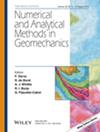Numerical Investigation of Mechanical Response of Sand‐Rubber Mixture by Material Point Method
IF 3.4
2区 工程技术
Q2 ENGINEERING, GEOLOGICAL
International Journal for Numerical and Analytical Methods in Geomechanics
Pub Date : 2025-05-31
DOI:10.1002/nag.4011
引用次数: 0
Abstract
Sand‐rubber mixture (SRM), a composite material made of recycled rubber and sand, is gaining increasing attention in construction engineering due to its lightweight nature, cost‐effectiveness, ease of processing, and other advantages. However, the mechanical behavior of SRM remains a complex issue as the addition of rubber not only increases the types of contacts between grains, but also changes the contact topology with rubber undergoing significant deformation. This study presents a numerical investigation of the intricate mechanical behavior of SRM based on the material point method (MPM) tailored for modeling the assembly of deformable grains. The employed approach introduces multiple meshes for handling the kinetic and deformation of individual grains and a discrete element method (DEM)‐type contact algorithm to directly address the intricate interaction in SRM, being capable of accurately modeling the complex behavior of SRM. Furthermore, rubber membranes in the biaxial shear test are simulated with material points with sufficient deformation capacity to accurately simulate the actual loading boundary. We first validated the accuracy and effectiveness of the proposed method through a series of benchmarks. Subsequently, one‐dimensional compression and biaxial shear simulations were conducted on the SRM to investigate the influence of rubber content (RC) and confining pressures. Both macroscopic deformation and the microstructural characteristics are examined. The results indicate that increasing RC leads to a more uniform contact force distribution, and a more stable force chain network, while higher confining pressure enhances the particle connectivity within the SRM.砂-橡胶混合料力学响应的物质点法数值研究
砂胶混合物(SRM)是一种由再生橡胶和沙子制成的复合材料,由于其重量轻、成本效益高、易于加工和其他优点,在建筑工程中越来越受到关注。然而,由于橡胶的加入不仅增加了颗粒之间的接触类型,而且由于橡胶发生了显著的变形而改变了接触拓扑结构,因此SRM的力学行为仍然是一个复杂的问题。本文提出了一种基于材料点法(MPM)的SRM复杂力学行为的数值研究,该方法是为模拟变形颗粒的组装而设计的。该方法引入了多个网格来处理单个颗粒的运动和变形,并采用离散元法(DEM)型接触算法来直接处理SRM中复杂的相互作用,能够准确地模拟SRM的复杂行为。采用具有足够变形能力的材料点模拟橡胶膜的双轴剪切试验,准确模拟实际加载边界。我们首先通过一系列基准测试验证了所提出方法的准确性和有效性。随后,在SRM上进行了一维压缩和双轴剪切模拟,以研究橡胶含量(RC)和围压对SRM的影响。研究了材料的宏观变形和微观组织特征。结果表明:增大RC可使接触力分布更均匀,力链网络更稳定,而增大围压可增强SRM内颗粒的连连性。
本文章由计算机程序翻译,如有差异,请以英文原文为准。
求助全文
约1分钟内获得全文
求助全文
来源期刊
CiteScore
6.40
自引率
12.50%
发文量
160
审稿时长
9 months
期刊介绍:
The journal welcomes manuscripts that substantially contribute to the understanding of the complex mechanical behaviour of geomaterials (soils, rocks, concrete, ice, snow, and powders), through innovative experimental techniques, and/or through the development of novel numerical or hybrid experimental/numerical modelling concepts in geomechanics. Topics of interest include instabilities and localization, interface and surface phenomena, fracture and failure, multi-physics and other time-dependent phenomena, micromechanics and multi-scale methods, and inverse analysis and stochastic methods. Papers related to energy and environmental issues are particularly welcome. The illustration of the proposed methods and techniques to engineering problems is encouraged. However, manuscripts dealing with applications of existing methods, or proposing incremental improvements to existing methods – in particular marginal extensions of existing analytical solutions or numerical methods – will not be considered for review.

 求助内容:
求助内容: 应助结果提醒方式:
应助结果提醒方式:


